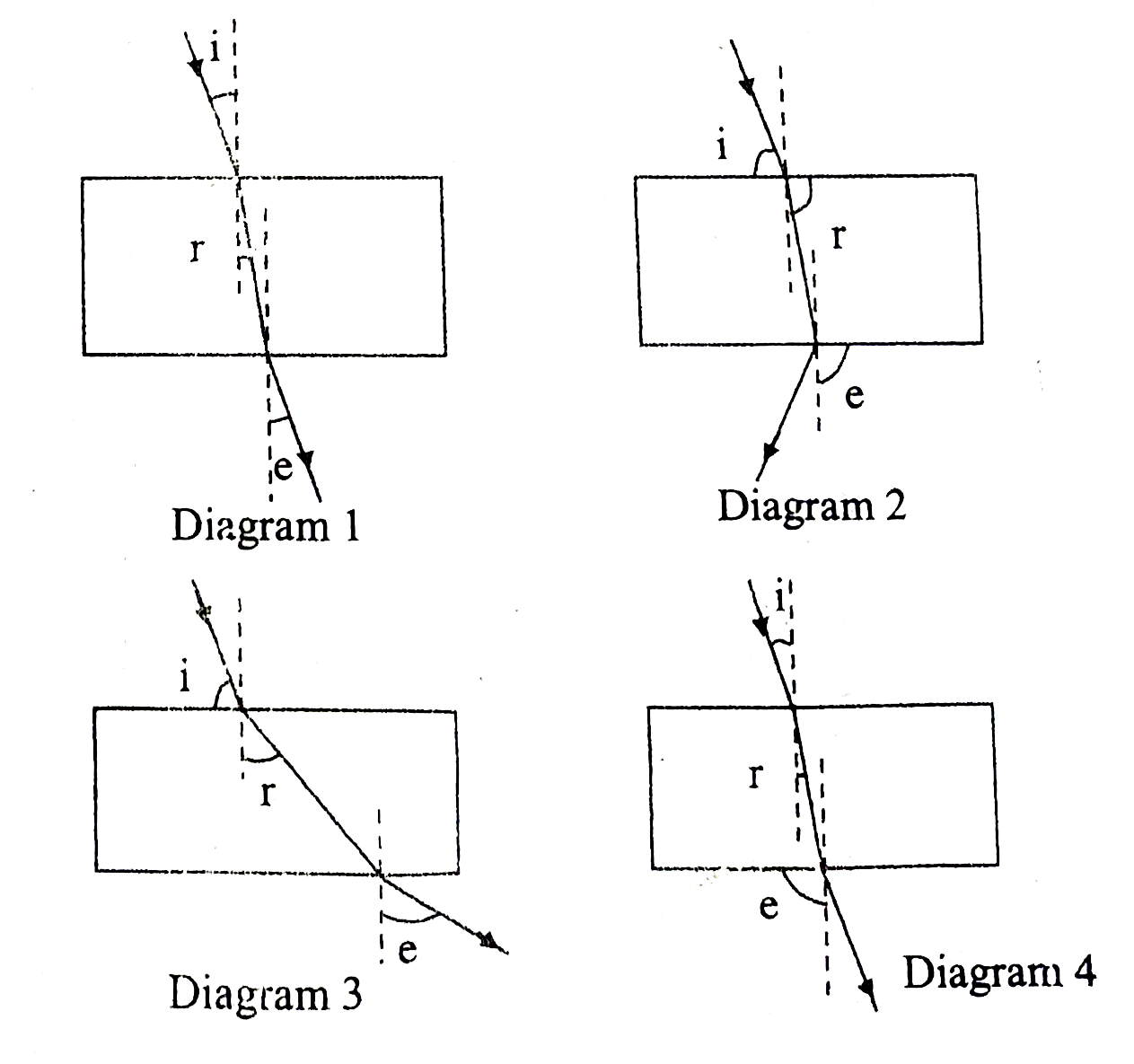In an experiment to trace the path of a ray of light passing through a rectangular glass slab, four students measured the angles of incidence (i), angles of refraction (r) and angles of emergence (e) as shown in the diagrams :

The correct measurement is given in the diagram :
A
B
C
D
The correct Answer is:C
NA
Topper's Solved these Questions
- BOOK - LAKHMIR SINGH & MANJIT KAURCHAPTER - THE HUMAN EYE AND THE COLOURFUL WORLD EXERCISE - Long Answer Type Question3videos
THE HUMAN EYE AND THE COLOURFUL WORLD
- BOOK - LAKHMIR SINGH & MANJIT KAURCHAPTER - THE HUMAN EYE AND THE COLOURFUL WORLD EXERCISE - NCERT Book14videos
THE HUMAN EYE AND THE COLOURFUL WORLD
- BOOK - LAKHMIR SINGH & MANJIT KAURCHAPTER - THE HUMAN EYE AND THE COLOURFUL WORLD EXERCISE - Long Answer Type Questions2videos
THE HUMAN EYE AND THE COLOURFUL WORLD
- BOOK - LAKHMIR SINGH & MANJIT KAURCHAPTER - TEST PAPER 4EXERCISE - SECTION A10videos
TEST PAPER 4
Similar Questions
In an experiment, the path of a ray of light passing through a rectangular glass slab was traced by a student. Which of the following diagram shows correct measurement of angle of incidence (i), refraction (r ), and emergence (e ) ?
 View Solution
View SolutionAn experiment to trace the path of a ray of light through a rectangular glass slab was performed by four students I, II, III, IV. They reported the following measurements of angle of incidence __ angle of refraction ___ and angle of emergence __ Which one of the students has performed the experiment correctly ?
 View Solution
View Solution
Knowledge Check
- Question 1 - Select One
In an experiment to trace the path of a ray of light through a triangular glass prism, a student would observe that the emergent ray
Ais parallel to the incident ray.Bis along the same direction of incident ray.Cgets deviated and bends towards the thinner part of the prism.Dgets deviated and bends towards the thicker part (base) of the prism. - Question 2 - Select One
A student performs the experiment on tracing the path of a ray of light passing through a rectangular glass slab for different angles of incidence. He measures the angle of incidence ∠i, angle of refraction ∠r and angle of emergence ∠e for all his observations. He would find that in all cases :
A∠i is more than ∠r but (nearly) equal to ∠eB∠i is less than ∠r but (nearly) equal to ∠eC∠i is more than ∠e but (nearly) equal to ∠rD∠i is less than ∠e but (nearly) equal to ∠r - Question 3 - Select One
A student traces the path of a ray of light passing through a rectangular glass. Slab.

For measuring the angle of incidence, he must position the protractor in the manner shown in figure :AABBCCDD
A student carries out the experiment of tracing the path of a ray of light through a rectangular glass slab, for two different values of angle if incidence ∠i=30∘ and ∠i=45∘. Find the set of values of the angle of refraction (∠r) and the angle of emergence (∠e)she is likely to observe in the two cases.
View SolutionA student carries out the experiment of tracing the path of a ray of light through a rectangular glass slab, for two different values of angle if incidence ∠i=30∘ and ∠i=45∘. Find the set of values of the angle of refraction (∠r) and the angle of emergence (∠e)she is likely to observe in the two cases.
View SolutionIn the experiment to trace the path of a ray of light through a parallel sided glass slab, a student measured the angles of refraction for three different angles of incidence. He will find that :
View SolutionIn the experiment on tracing the path of a ray of light passing through a rectangular glass slab, the correct setting of the protractor (D), for measuring the angle of incidence (∠I), and the angle of emergence (∠e) correspond, respectively, to diagrams :
 View Solution
View SolutionIn an experiment to study the refraction of light through a rectangular glass slab, a student measured the angle of incidence, angle of refraction and the angle of emergence, The student lost the reading of angle of incidence but noted the readings of angle of refraction to be 35∘ and angle of emergence to be 65∘. The angle of incidence is likely to be :
View Solution

